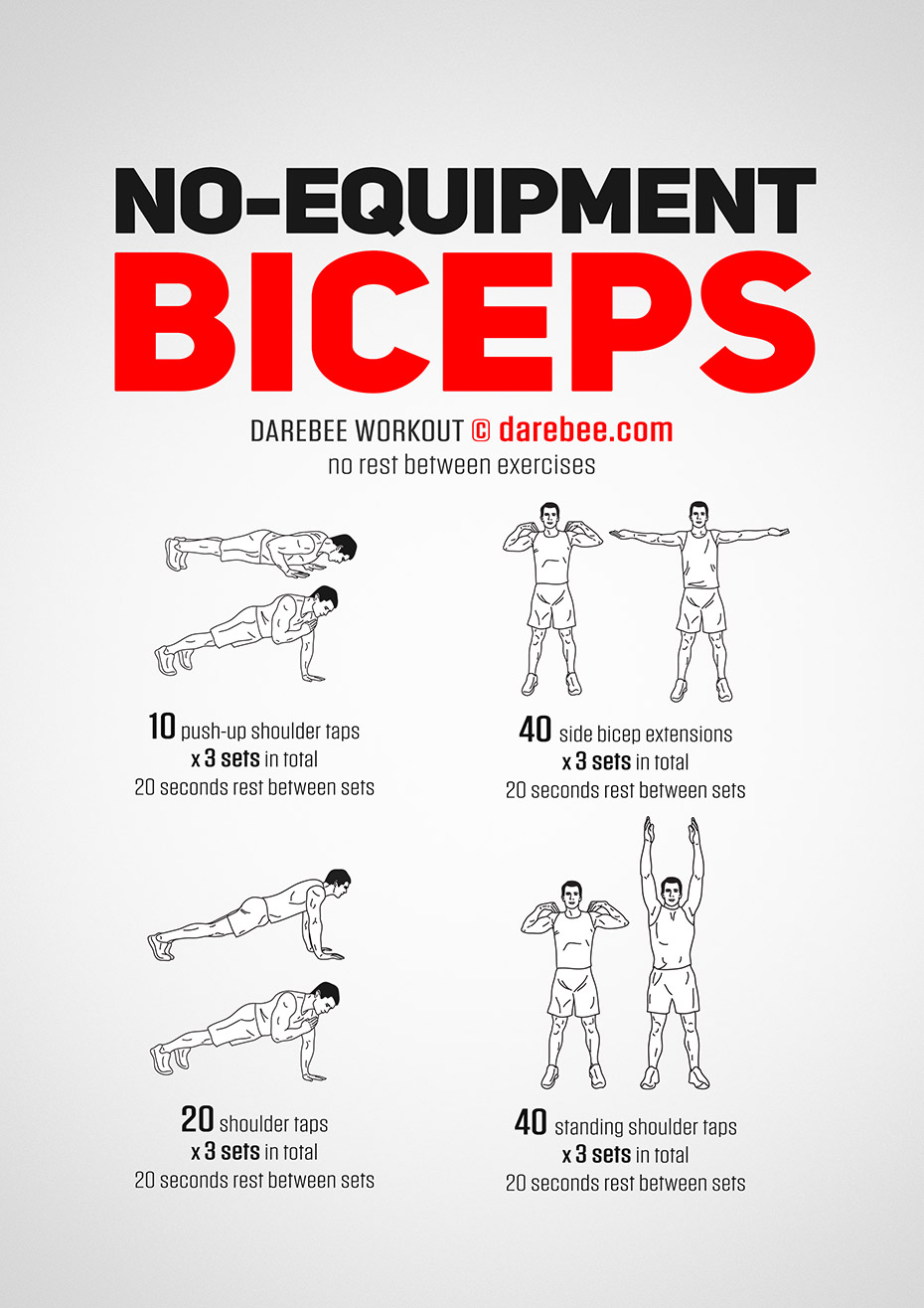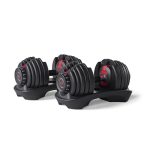Building strong biceps doesn’t always require fancy equipment. You can achieve great results at home without weights.
Imagine sculpting your arms using just your body weight. It’s possible and effective. Home bicep workouts without weights focus on using simple techniques. These exercises fit into busy schedules. They’re perfect for those who prefer privacy. Bodyweight exercises are also safer than lifting weights.
You reduce the risk of injuries. Plus, you need minimal space. This workout suits small apartments or crowded rooms. Ready to learn how simple moves can strengthen your arms? Discover how to make the most of what you already have at home. Get ready for a practical approach to bicep training. Your fitness journey starts here, without any heavy lifting.
Credit: play.google.com
Benefits Of Bodyweight Exercises
Bodyweight exercises offer many benefits for fitness enthusiasts. They are effective for building muscle and improving strength. Without any equipment, they provide a full-body workout.
These exercises focus on using your own weight. This helps improve balance and coordination. They are great for all fitness levels.
Convenience And Flexibility
Bodyweight exercises fit into busy schedules. They can be done anytime, anywhere. No need for a gym or special gear.
These workouts adapt to different spaces. Whether in a small apartment or a large park. You can exercise at home or while traveling.
Building Strength Without Equipment
Bodyweight exercises help build strength effectively. They target different muscle groups. This includes biceps, triceps, and shoulders.
Push-ups and pull-ups enhance upper body strength. Squats and lunges build lower body power. Core exercises strengthen the abs and back.
With consistent practice, muscles grow stronger. You gain endurance and improve muscle tone.
Anatomy Of The Biceps
Understanding the anatomy of the biceps is crucial for effective home workouts without weights. Knowing what you’re targeting can help you maximize your efforts and achieve visible results. Let’s dive into the structure and the role of this essential muscle.
Bicep Muscle Structure
The biceps are located at the front of your upper arm, consisting of two main parts: the long head and the short head. These heads work together to form the recognizable bulge that many aim to build. The long head originates from the shoulder blade, giving your bicep its peak when flexed. The short head starts at a different point on the shoulder blade and adds width to your arm.
Both heads attach to the forearm bones via the bicep tendon. This dual-headed structure allows the biceps to perform various functions effectively. Next time you’re flexing your arm, remember the teamwork happening underneath your skin.
Role In Arm Movement
Your biceps are key players in arm movement, especially in actions like lifting or pulling. They help bend your elbow, bringing your hand closer to your shoulder. This movement is crucial for daily activities like picking up groceries or even waving hello.
Additionally, the biceps assist in forearm rotation, allowing you to turn your palm up or down. Imagine opening a jar or handling a screwdriver; your biceps are working hard behind the scenes. Understanding these roles can help you tailor your workouts to enhance these everyday movements.
As you plan your home bicep workouts, consider how these muscles operate. Which exercises mimic these natural movements? How can you challenge your biceps without weights? Your body is a sophisticated machine, and knowing its mechanics can lead to smarter, more effective workouts.
Warm-up Techniques
Before diving into your home bicep workout, it’s essential to prepare your body with effective warm-up techniques. Doing so not only reduces the risk of injury but also enhances your performance. Picture this: you’re about to start your workout, but your muscles feel stiff and unprepared. A good warm-up sets the tone for an efficient session, helping you make the most of your efforts.
Dynamic Stretching
Dynamic stretching is all about movement. It wakes up your muscles and gets your blood flowing. Try arm swings—extend your arms to the sides and swing them forward and backward. Feel the energy surge as your muscles activate.
Leg kicks are another great option. Stand tall, and kick one leg forward while keeping the other planted. These stretches not only prepare your biceps but also engage your core. A friend once told me how dynamic stretching transformed her workouts; she felt more agile and ready to tackle each exercise.
Joint Mobility Exercises
Joint mobility exercises are crucial for your warm-up routine. They ensure that your joints are ready to move through their full range of motion. Start with shoulder circles. Rotate your shoulders in a circular motion, first clockwise, then counterclockwise. This simple move can make a difference.
Wrist circles are equally important, especially for bicep workouts. Imagine your wrists as hinges; you want them smooth and flexible. Rotate them in circles and feel the tension ease. Joint mobility prepares your body for the demands of your workout, helping you avoid any discomfort.
Have you ever skipped a warm-up and regretted it halfway through your workout? Ensuring your muscles and joints are ready can be the key to a successful session. Warm-ups are not just a chore; they are an essential part of your fitness journey. Embrace them, and your workouts will thank you!

Credit: www.pinterest.com
Push-up Variations
Working out at home without weights doesn’t mean compromising on muscle growth. Push-up variations are a fantastic way to target and strengthen your biceps effectively. These exercises are simple, require no equipment, and can be done virtually anywhere. You might be surprised at how a little change in hand position can make a big difference in your workout.
Standard Push-ups
Standard push-ups are a staple in any bodyweight routine. They engage not just your chest and triceps, but also your biceps. Begin in a plank position, keeping your body straight. As you lower yourself, focus on engaging your biceps along with your core. It’s not just about pumping out reps; it’s about quality. How many can you do with perfect form?
Try setting a goal each week to increase your count by a few reps. It’s motivating to see improvement over time. If you find this too easy, slow down your pace or hold your position at the bottom for a few seconds. It adds an extra challenge and keeps your muscles guessing.
Diamond Push-ups
Diamond push-ups take the intensity up a notch. Place your hands close together under your chest, forming a diamond shape with your thumbs and index fingers. This variation shifts more focus onto your triceps and biceps, providing a great burn.
When I first tried diamond push-ups, I was surprised at how quickly my arms fatigued. It’s a clear sign of their effectiveness. If you struggle initially, start with your knees on the ground. As you build strength, transition to a full push-up position. The sense of accomplishment is worth the effort.
Are you ready to test your limits? Incorporate both of these push-up variations into your routine to maximize your bicep workout at home. Remember, consistency is key. Keep challenging yourself, and you’ll be amazed at the progress.
Plank-based Exercises
Plank-based exercises strengthen the biceps without weights. They engage multiple muscle groups. These exercises boost strength and flexibility. Plus, they’re perfect for home workouts.
Plank To Push-up
The plank to push-up works your biceps and core. Start in a plank position. Your body should form a straight line. Lower one arm to the ground. Follow with the other arm. Now, you’re in a push-up position. Reverse the steps to return to plank. Repeat this movement. It challenges your stability and strength.
Side Plank Rotations
Side plank rotations target biceps and obliques. Begin in a side plank position. Support your weight on one forearm. Your body should be in a straight line. Extend your top arm towards the ceiling. Slowly rotate your torso. Bring your top arm under your body. Rotate back to the starting position. These rotations improve balance and arm strength.
Isometric Holds
Isometric holds might be your next big thing in home bicep workouts, especially if weights aren’t your cup of tea. These exercises focus on muscle tension without movement, offering a unique way to engage your biceps. Holding a position challenges your muscles to maintain tension, building strength and endurance over time.
Wall Sits For Arms
Have you ever tried wall sits, but for your arms? Stand against a wall as if you’re preparing for a traditional wall sit. Now, extend your arms out in front of you, parallel to the floor. Hold this position, keeping your elbows slightly bent. Feel that burn in your biceps?
Wall sits for arms are a great way to add intensity to your workout without any equipment. It’s surprising how a simple hold can make your muscles work so hard. Aim to hold the position for at least 30 seconds, gradually increasing the duration as you get stronger.
Static Arm Holds
Static arm holds are another fantastic isometric exercise. Stand or sit comfortably, extend your arms to your sides, palms facing upward, as if holding invisible trays. Maintain slight tension in your biceps and hold this position steady.
Challenge yourself by timing your holds. Can you manage a minute? You might be surprised at how tough it gets after just a few seconds. This exercise doesn’t just work your biceps; it also engages your shoulders and forearms.
Why not try incorporating these into your daily routine? They’re perfect for squeezing in a quick workout while watching TV or waiting for your coffee to brew. What’s your experience with isometric holds? Have you found them to be effective in your fitness journey?
Creative Household Exercises
When you think of bicep workouts, weights usually come to mind. But, you can build strength using household items. Creative exercises at home can be just as effective. They also make your workout routine fun and flexible.
Towel Curls
A towel can be a handy workout tool. Roll it up tightly. Hold one end in each hand. Stand with your feet shoulder-width apart. Keep your elbows close to your sides. Pull the towel upwards. Your hands should move towards your shoulders. Squeeze your biceps at the top. Then, lower the towel slowly. Repeat for a set of ten curls. Rest and repeat the cycle. This exercise targets your biceps efficiently.
Chair Dips
Grab a sturdy chair for this exercise. Place your hands on the edge of the seat. Your fingers should point forward. Keep your feet flat on the ground. Slide your body off the chair. Lower yourself slowly until your elbows form a 90-degree angle. Push yourself back up to the starting position. Perform this exercise for ten repetitions. Chair dips also work your triceps, adding arm strength.
Incorporating Progressions
Boost your home bicep workout by incorporating progressions. Start with simple exercises like push-ups. Gradually increase difficulty with variations such as incline push-ups or isometric holds. Keep challenging your muscles for better strength and definition, all without any weights needed.
Progressions in your home bicep workout are key to keeping your muscles growing and preventing workout boredom. Without weights, it might seem challenging at first, but you can still effectively build your biceps by making small adjustments to your routine. These progressions can be as simple as increasing the number of repetitions or as dynamic as advancing to more complex moves. ###Increasing Repetitions
Start by adding more reps to your current exercises. If you’re doing bicep curls with resistance bands, aim to perform more each week. Track your progress. Keep a journal or use a fitness app to note how many you accomplish. Challenge yourself to beat your previous record. This pushes your muscles to adapt and grow stronger. ###Advancing To Complex Moves
Once you’re comfortable, integrate more challenging exercises. Try negative curls or isometric holds to target your biceps differently. Combine moves to create a complex exercise. For example, pair a bicep curl with a shoulder press using resistance bands. Think about how your body responds. Are you feeling the burn in a new way? This is a sign that you’re on the right track. Have you ever tried a new exercise and felt muscles you never knew existed? That’s the magic of progression. It keeps your workouts fresh and your muscles guessing. How will you make your next home workout more challenging?Cooldown And Stretching
After completing your home bicep workout, it’s essential to focus on cooldown and stretching. This helps relax your muscles and prevent stiffness. Cooling down also aids in recovery, allowing your body to heal and grow stronger. Stretching is vital for maintaining flexibility and promoting blood flow. Let’s explore some effective techniques to conclude your workout session.
Gentle Arm Stretches
Begin with gentle arm stretches to ease tension in your biceps. Extend your right arm straight in front of you. Use your left hand to gently pull your right arm across your chest. Hold this stretch for 20 seconds. Repeat the same with your left arm. Feel the stretch in your bicep and shoulder.
Another effective stretch involves standing tall and interlocking your fingers behind your back. Slowly straighten your arms and lift them upwards. This opens your chest and stretches your biceps. Hold for 15 seconds, then release. Repeat this stretch twice for maximum benefit.
Relaxation Techniques
Relaxation techniques are crucial for ending your workout on a peaceful note. Deep breathing calms your mind and body. Sit comfortably, close your eyes, and inhale slowly through your nose. Hold your breath for a moment, then exhale gently through your mouth. Repeat this breathing cycle five times.
Visualization is another effective relaxation method. Picture a serene landscape like a beach or forest. Imagine yourself there, feeling relaxed and at ease. This mental escape helps reduce stress and enhances your post-workout recovery.
Incorporating these cooldown and stretching exercises will improve your fitness journey. They enhance your workout routine and prepare your body for the next session.

Credit: in.pinterest.com
Tracking Progress
Tracking progress in home bicep workouts without weights helps monitor improvements. Simple exercises can build strength over time. Documenting each session encourages consistency and boosts motivation.
Tracking Progress in your home bicep workout without weights is crucial for achieving your fitness goals. It’s not just about doing the exercises; it’s about understanding your growth and setting benchmarks. This process helps keep your motivation high and ensures that your workouts continue to challenge you effectively. Whether you’re a beginner or seasoned athlete, tracking your progress makes a significant difference.Recording Workouts
Recording your workouts is the first step in tracking progress. Keep a simple log of your daily routines. Note the exercises, repetitions, and the duration of each session. A notebook or a digital app can help you stay organized. Seeing your progress on paper or screen can be incredibly motivating. You can identify patterns and see when you’re at your strongest or when you need to push harder. Consider creating a table with columns for each exercise, reps, and notes about how you felt. Did you find a particular exercise easier than last week? Write it down. These insights will guide your future workouts.Setting New Goals
Setting new goals keeps your workouts fresh and exciting. Reflect on the progress you’ve logged. Are there certain exercises where you’ve plateaued? Aim to increase your reps or add more sets. Break larger goals into smaller, achievable milestones. If you want to double your reps, start by adding five more to each session. Gradually increase as your strength builds. Ask yourself: What do I want to achieve in the next month? What will challenge me? Use these questions to steer your goals. This approach ensures that your workout evolves with you, staying aligned with your growing strength and endurance. Tracking your progress is about knowing where you stand and where you’re headed. It’s not just a record—it’s a roadmap to your fitness success. By recording workouts and setting new goals, you empower yourself to grow stronger, one session at a time.Frequently Asked Questions
Can You Grow Biceps Without Weights?
Yes, you can grow biceps without weights. Perform bodyweight exercises like push-ups, pull-ups, and dips. Utilize resistance bands for added intensity. Ensure proper form and consistency in your routine. Focus on progressive overload to continuously challenge muscles and stimulate growth.
Can I Do Bicep Curls Without Weights?
Yes, you can do bicep curls without weights using resistance bands, water bottles, or bodyweight exercises. These alternatives effectively target the bicep muscles. Focus on slow, controlled movements to maximize muscle engagement and growth. Adjust resistance levels to match your fitness needs and goals.
Can Push-ups Build Biceps?
Push-ups primarily target the chest, shoulders, and triceps. They can engage biceps as secondary muscles. For significant bicep growth, incorporate exercises like bicep curls and chin-ups. Push-ups alone provide limited bicep development. Consistent strength training and varied exercises enhance overall arm growth.
Are 4 Exercises Enough For Biceps?
Four exercises can effectively target biceps growth. Focus on variety, intensity, and proper form. Include curls, hammer curls, and chin-ups for balanced development. Adjust weight and reps to challenge muscles. Consistency and progressive overload are key for optimal results. Always listen to your body and avoid overtraining.
Conclusion
Achieving strong biceps at home is possible without weights. Simple exercises like push-ups and planks build muscle effectively. Consistency is key. Repeat these workouts regularly for best results. Gradually increase repetitions to challenge your muscles. Always maintain proper form to prevent injury.
Listen to your body; rest when needed. A balanced diet supports muscle growth. Hydration is vital for recovery. Celebrate small progress along the way. Enjoy the journey to stronger biceps. Keep moving forward with determination. Your efforts will pay off in time.
Remember, fitness is a lifelong commitment. Stay motivated and focused on your goals.





